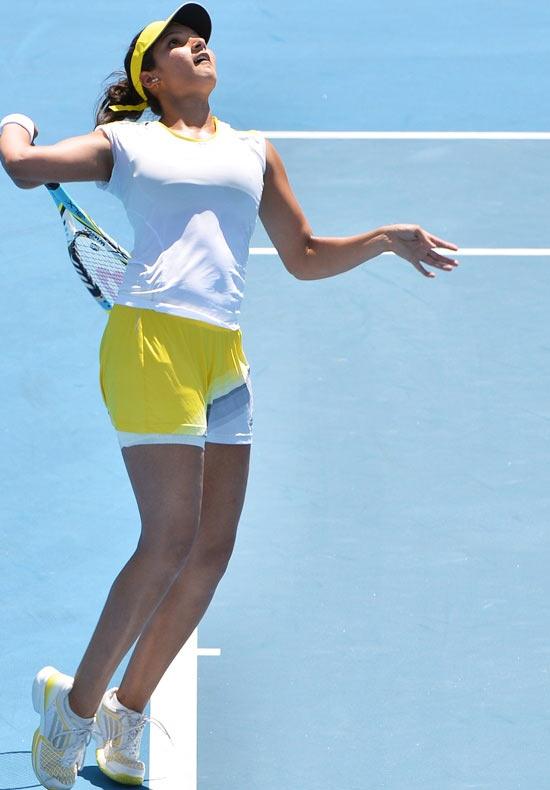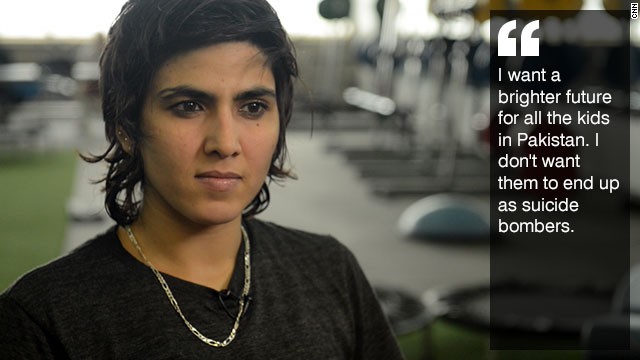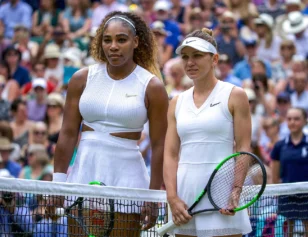High level athletes have a variety of adversaries.
They battle opponents, teammates, organizations, angry fans and even themselves.
And, for some, they battle their own culture.
***
I remember having a thousand people for security, professional tennis player Sania Mirza told the New York Times in 2013. Fatwa had been declared against Mirza in 2005 by cleric Haseeb-ul-hasan Siddiqui for her indecent dressing.
Fatwa, edict/decree/ruling, is made in accordance with Islamic law by a religious leader. It points to a specific point(s) in Islams holy book, the Koran. In Mirzas case, what Western society would consider as fashionable attire, Islam considers forbidden.
What type of attire? Standard tennis attire.

(Photo Credit: reddif.com)
As a result of the fatwa, there was concern that certain religious groups would take action at an Indian tournament. Although nothing happened, it highlights the off-court struggle of the nation and regions top female athlete. Every move, interview, outfit, social media post is reviewed and analyzed against what society and religion view as acceptable.
What must it be like to be gifted with athletic talent but having to fight against societal or, in Mirzas case, religious norms?
***
In much of North America, people are able to play and practice their sport anytime and anywhere. A young hoopster or soccer player can practice in their backyard, at the local park or in the street without fear of reprisal. But, in the mountain region of Pakistan called Waziristan, one young woman remembers posing as a boy just to live a normal life.
Maria Toorpakai is a talented young squash player who, like Sania Mirza, has had to fight against traditional dogmas of the region. Toorpakai hails from Waziristan, which happens to be home of the Taliban. Un-Islamic is how women playing sports is viewed. Despite that, Toorpakai had an ace in her pocket: the support of her (progressive) father. He raised my brothers and us equally as sons and daughters come from the same womb, she recently told CNN.
Toorpakai would fight with boys, even taking up weightlifting and, at one point, burn her girly clothes and cut her hair in an effort to fight for her right to be whatever she wanted. But, as she got older, her desire to do what she wanted would cost her.
There was a time when I could not even go outside at all, Toorpakai told CNN. “For more than three years, I could only train in my own room.
This was as a result of death threats leveled against her. Reason? For wearing shorts and not wearing a veil while playing.

(Maria Toorpakai, Photo Credit: cnn.com)
Amidst the controversy, Toorpakai always had squash. Her love of squash drove her to begin reaching out to clubs, schools – any place that believed in the sport – to see if there was a place she could train and grow. It took years, but she finally received an answer 2011 when Jonathon Power, the first North American squash player to ever attain the worlds #1 ranking, who invited her to train at his academy in Canada.
When I got his message I was just so happy. I couldn’t believe it, Toorpakai told CNN.
Today, Toorpakai lives and trains in Canada, but she is still considered one of the top players in Pakistan, a country with a long, successful history in squash. The memories of her childhood arent far from her mind, however. She has created the Maria Toorpakai Foundation to help children reach their full potential so no child has to endure what she went through. She is using sport to make a difference.
***
Dipa Karmakar.
Know the name before Rio this summer because youre sure to hear at least a story or…a few about Karmakar.
She is a 22-year-old gymnast who recently became the first Indian gymnast to qualify for the Olympics. She will compete in the womens vault in Rio. Not impressed? Watch this:
The difficulty in performing the Produnova, as that vault is called, cannot be underestimated. And yet, here was Karmakar nailing it at a high profile event and saying to the world, Hello, I am here! She became only the third woman to ever complete this maneuver in competition.
Its an amazing achievement for Karmakar and the country of India. When one thinks about Indian or South Asian sports, its cricket and then everything else. Gymnastics probably wouldnt crack the top 5, so Karmakars achievement is momentous. India will be sending a potential medal winner to the games.
This is huge – a very great accomplishment that we should be highlighting more, Neha Contractor, founder of South Asians In Sports, told The Shadow League via email.
No such worries in Karmakars native India. Everyone from the prime minister to cricket legends like Sachin Tendulkar have sent along their well wishes and congratulations.
Dipa Karmakar. Remember the name.
***
With 7 million likes on Facebook, 1.5 million followers on Twitter and 329k followers on Instagram, it is safe to say that Saina Nehwal is the second most popular female athlete in India. She is second only to the aforementioned Sania Mirza – she of the 10 million Facebook likes, 3 million Twitter followers and 1.3 million Instagram followers.
Never heard of Saina Nehwal? Thats probably because Nehwal plays a sport that most Americans only play in elementary school or at someone elses backyard party: badminton.
Although it pales in comparison to the behemoth that is cricket in India, badminton is finding a niche in this country of over 1.2 billion people. Key to it all are athletes like Nehwal who are finding success on some of the biggest stages of the world. The shuttler (badminton term) took home a bronze at the 2012 London Olympics.

(Photo Credit: deccanchronicle.com)
Nehwal is currently the #8 ranked womens player in the world, having reached #1 as recently as 2015. She will be leading the largest badminton contingent ever for India into the Rio games this summer. But what does it matter in a cricket-mad country like India? Nehwal has some thoughts.
Contractor echoes this videos sentiment, saying Sports is not an area where most South Asian families feel their children should make a living in. There are many that don’t get that support.
Fortunately for Nehwal, she has had the support of her family from the beginning. And that includes her father. Harvir Singh Nehwal and his wife, Usha Rani, sacrificed whatever they could to give to their daughters blossoming badminton career growing up.
I had a fixed income as a government servant. I couldnt afford to buy her top of the line equipment, Harvir told Al-Jazeera in 2015.
Borrowing money from family or friends was the only way they could afford to keep Nehwal in the sport. Equipment, training and travel are all part of the cost. Not everyone has that kind of support, which is the point of the above video.
Nehwals goal for the immediate future is Rio. But, for now and in the long-term, her aim is to help anyone reach for their dreams.
***
I once heard a conference speaker say, When youve got the mic, use it! Terrific advice. The challenge in that, however, is getting to the mic in the first place.
Success gets you noticed. Whether a sports athlete or journalist, the more success you have, the greater the platform from which to speak. Sania Mirza has that platform and she is using it to effect positive change in the world. She became the first South Asian woman to be named a United Nations Goodwill Ambassador in 2014. And she continues to fight for gender equality, particularly in sports.
Sania is a true role model for all South Asians in this industry with her success on the court as well as off the court, said Contractor.
Contractor originally created sainsports.com, and subsequent Twitter chats, to help highlight the achievements of South Asian women (SAW) in sports. But, Contractor saw a need to unite what all South Asians were doing in the industry.
The accomplishments and impact that both Mirza and Nehwal have had has been tremendous in India and around the world, she added.
But, they arent the only ones who have reached great heights in sports. Aditi Kinkhabwala is a well-known reporter for the NFL Network. Kinkhabwala previously worked at the Wall Street Journal. Names like Shamila Kohestani (former Afghanistan footballer), Mohini Bhardwaj (U.S. Olympic team champion) and Mary Kom (Indian boxing) are all helping blaze a trail for young South Asian women today.
According to writer Chandrima Chatterjee, the recent South Asian Games added womens basketball, womens volleyball and womens football to the competition. While great strides have been made, some old ways of thinking still persist. At the Games, several female track and field athletes were housed in a facility miles away from their venue while their male counterparts and coaches stayed in four-star hotels.
Change is a slow process. Women here in America and high-profile sports fight for equal pay, other parts of the world simply fight for a right to play. Women like Sania Mirza (who is a U.N. Goodwill Ambassador) and Maria Toorpakai are using the mic, so to speak, to advance the rights of young women and children through sport.
Opportunity comes with adversity for many South Asian female athletes. But, change of any kind is never easy. Especially cultural change. For some, its more than just playing a sport. Its about having a seat at the table, being a part of the conversation.
***
Many eyes will be on Sania Mirza over the next two weeks as she and her partner, Martina Hingis, will be going for the Santina Slam. Mirza and Hingis currently hold the womens doubles titles at Wimbledon, the U.S. Open and the Australian Open. The French is the only title that has eluded them.
A victory at Roland Garros will secure the career Grand Slam for the pair. They will be, if theyre not already, in the conversation of greatest doubles teams of all time.
In the conversation. Not just a womens conversation but both sexes.
An entire nation will be watching Mirza. An entire region will be observing. Many young Indian girls will take it all in with wide-eyed wonder, hoping that they too can be like Sania someday. Whether it be on the courts, the pitch, the ring, the mat or even in the political arena, young South Asian girls will be inspired to dream.
Dreaming of a world free of fatwas, discrimination and death threats for simply playing sports.
Daring to simply dream.



